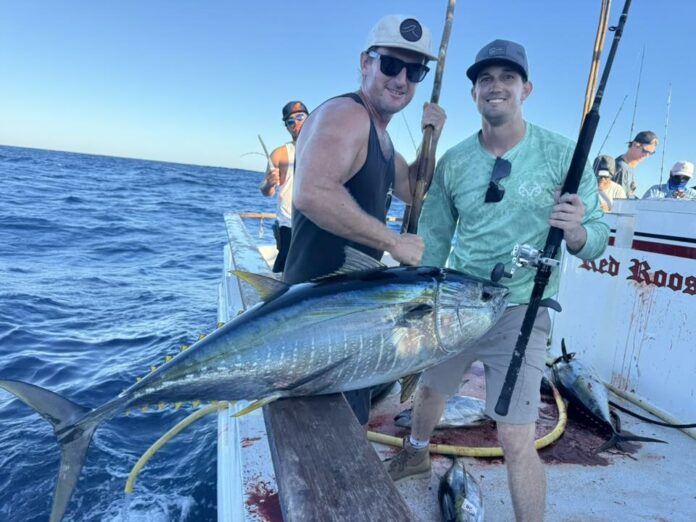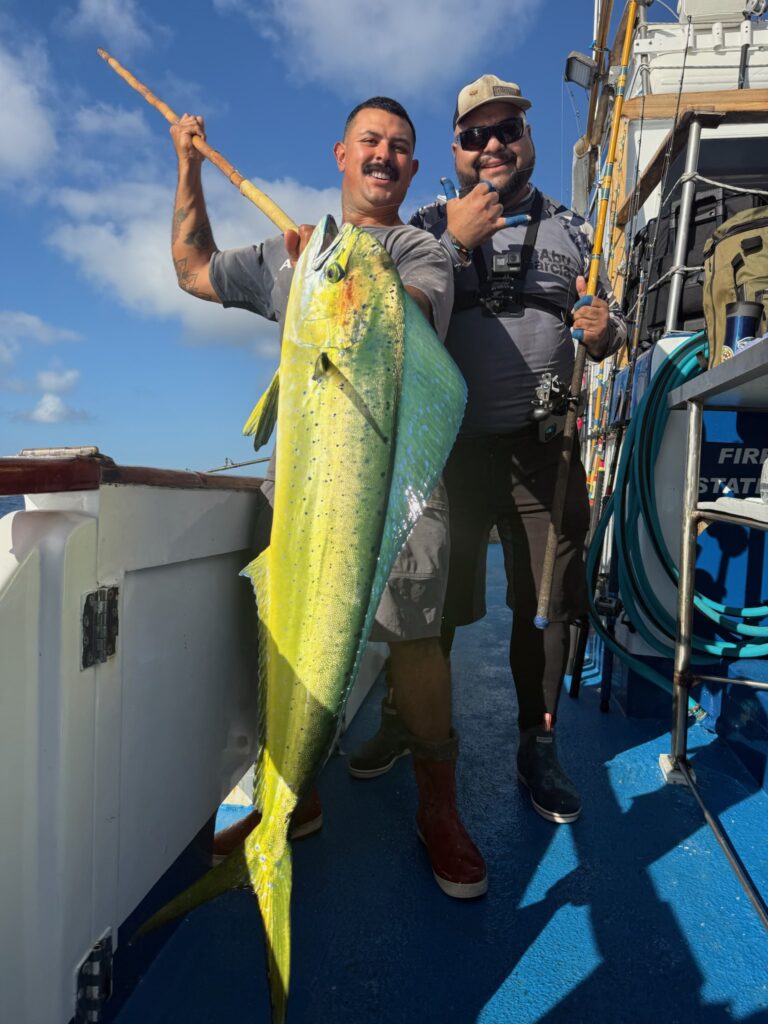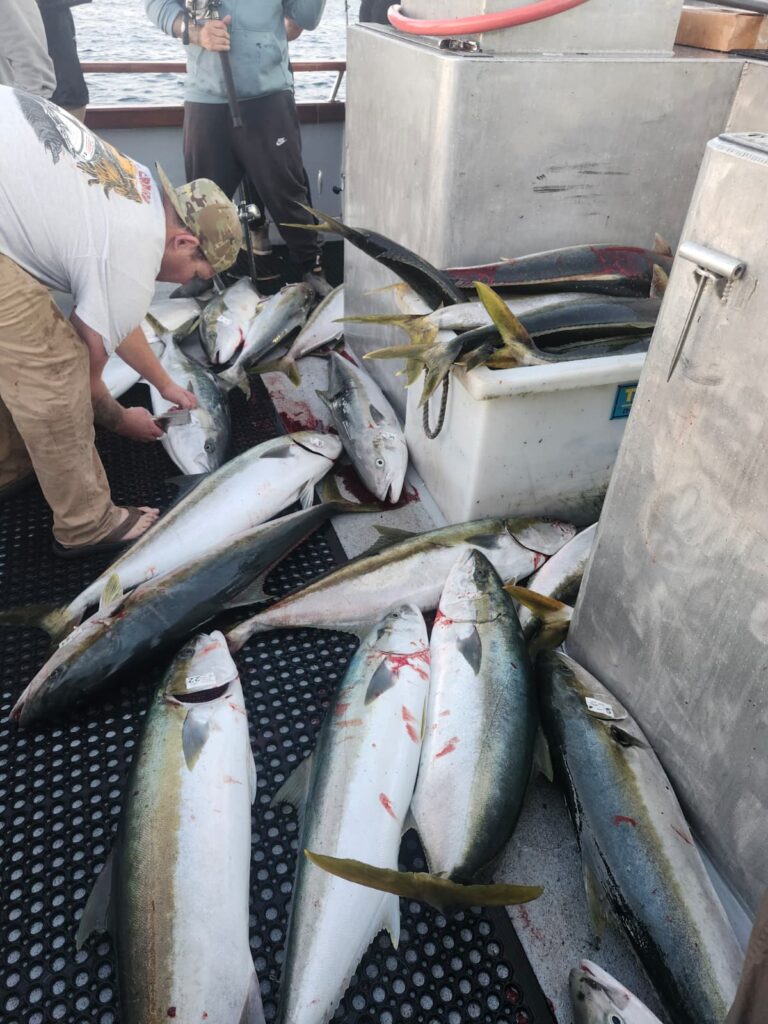
BY MERIT MCREA
It was 1978, I was a year out of high school and a newly minted 100-ton captain. The year prior I’d coasted through my senior year with enough units to graduate a semester early. I took a couple of classes in spring anyway, studied for that license, and did a bit of afternoon hand-powered skiff fishing. I skipped all the “senior activities” to take off a few weeks early and head down to San Diego aboard the Sundown, a charter boat I decked on weekends and holidays.
Capt. Taka Tanaka (today, Taka’s Tackle on Lincoln in Anaheim) had the Mustang across the dock. A couple seasons prior I’d caught my first albacore on that boat with his 3 boys decking. They were deck ninjas with enviable skills and speed. Taka, George Mio and Fuji were the triumvirate hot-shot skippers whose charters brought out the best food on the docks.
After that summer, we all headed offshore for commercial fishing, spanning waters from San Diego to above Morro Bay.
Winter was spent decking some, boat work, a couple of City College classes and I bought a bigger commercial skiff with which I ran a few sections of seabass gillnet at crack-of-dawn before heading off to class at 10. In spring, shortly after becoming eligible at age 19, I sat for the licensing test.

Another summer fishing San Diego, but when that was done I was back to Santa Barbara, almost instantly in the wheel house, running ½ and ¾-day trips, some island runs too.
That was the year that the Condor was launched. Robby Church, Fred Benko and I had a mixed schedule running that rig, then Church was mostly on that boat while I was on the Seahawk. It was ’83 and ‘84 when I ran the Condor full time and then the Seahawk for a few months before buying it in late 1984. The “Hawk” was originally the Miss L. Today it’s the Voyager out of Seaforth Sportfishing in San Diego.
The tech in those days was radar and paper fathometers, an electrified stylus scratching along the right-hand edge of a window of “meter paper” that slowly advanced across, burning a dark scratch where an echo was heard bouncing back off fish and bottom below. This painted a picture on the paper as it slowly scrolled, unrolling on the right and re-rolling on the left after passing before the window.
The old “flasher” was a part of this meter as well, but the flasher wheel meters were relics that were still aboard some of the older party boats. Radars were rare aboard skiffs for sure.
LORAN C was just coming into partyboat wheel houses but were an expensive proposition. This provided a new opportunity to pass the coveted knowledge of where the larger reefs were without having to be aboard the boat at the time.
But still, the reef locations were primarily the purview of professional mariners who had collected land marks and radar marks in note books dating back through their careers.
Exploring the west bank at San Miguel required running to the Wilson Fowl Area and running course and time while keeping a careful eye on the fathometer. If the weather was clear enough you could sight over the headlands and peaks of the island and get a land mark, plus a distance off the radar and log those for the next time.

It was all about land marks and radar ranges. Places got names like the 2×4 or the 10×10 based on radar marks, names that endure today. As I recall, the wreck of the SM-1 was a skosh past 3 miles from Government Point and almost exactly a mile offshore. That’s how you’d find it in the fog, that and a lot of circling around and being ready with a handful of paper plates to toss over when it showed on the meter.
Line-ups for the bass spots became etched into memory. Most of all, there was no reliable way to share that high-precision land mark knowledge without taking someone to the spot and showing them or letting them pick their own.
The casual private boater basically had little chance of loading up on bottom fish or even bass and most focused on drifting for halibut or trolling salmon, bonito and barracuda when they were around.
Even after LORAN C became available to the average private boater, the skill set needed to translate numbers flashing on a readout into directions and locations remained beyond the weekend warrior.
There was no way anyone could expect anyone else to be able to honor an arbitrary electronic line drawn across the open ocean, There were no invisible borders, no big offshore areas closed to fishing. The only fishing closures were small, close to the coast in shallow water and marked by buoys.
In a word, out on the water, unlike the hunters of the land, we were FREE – free to face only the limitations nature threw at us – wind and weather, waves and tides. It was freedom to do one’s best without a leash, without bounds, fences, signs, locked gates that only others had keys to.
Then came “Star Wars.” The “Star Wars” program refers to the Strategic Defense Initiative (SDI), proposed by President Ronald Reagan in 1983 – and the Global Positioning System.
Two decades later it was GPS and electronic plotters with plug-and-drive location finding on every boat. The new “secret spot” could be relayed over the radio or phone or listed in a book and anyone including a first-timer could find it.
Then it was drawing imaginary limits, fences beyond which the rules changed, or anglers were excluded from entirely. And this could be listed in law and relied upon for enforcement.
The playing field between the pros and the amateurs was greatly leveled.
Most of all, that freedom was gone.
It’s replaced by regulatory complexity as anglers endeavor to salvage as much access as we can from people with competing interests drawing imaginary fences across the open ocean.
Merit McCrea is SoCal saltwater editor for Western Outdoor News. A veteran Southern California partyboat captain, he is the Science and Fisheries Coordinator for the Sportfishing Association of California and a marine research scientist with the Dr. Milton Love Lab at the University of California at Santa Barbara’s Marine Science Institute. He currently serves on the Groundfish Advisory sub-Panel of the Pacific Fisheries Management Council, the Santa Barbara Harbor Commission, and the CCA-Cal State Board. He can be reached at: merit@wonews.com.



